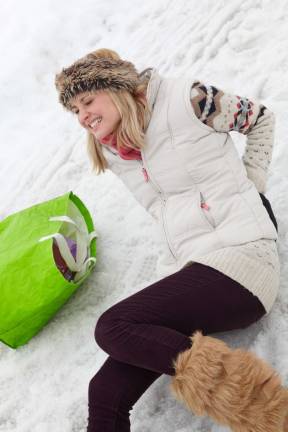Concussions, breaks on the rise

Bombarded with snow and freezing temperatures, this marks one of the harshest winters the tri-state area has experienced in a long time. It has also been one of the most dangerous in regards to winter-related injuries.
Orange Regional Medical Center in Middletown, N.Y. reported seeing an increase in snow related injuries including: back injuries, chest pain, falls and ankle, wrist and head injuries.
Breaks and concussions
The biggest contender this season are breaks and concussions from slips and falls.
"There has been a notable increase in the number of people slipping or falling on arms and legs," said Dr. David Stuhlmiller, Director of Emergency Medicine at Newton Medical Center in Newton, N.J. "More wrist fractures, more forearm fractures, more hip fractures this year from slip and falls. Usually from the ice and snow."
This year alone from January 1 through the end of February, Newton Medical Center has seen a total of 33 fractures — these are not all necessarily winter-related but a large portion are.
Janet Bailey, Clinical Director of Emergency Department at Bon Secour Community Hospital in Port Jervis, N.Y. also reported a significant increase in falls.
Falls were the fifth most common diagnosis for December 2013 compared to 2012 when falls was only 12th most frequent.
January also showed an increase compared to last year. In 2013 falls was ninth most common and this year it moved up to number seven.
"There are a lot more concussions," Stuhlmiller said. "People are striking their heads when they fall and twice as many of the people are breaking something."
And these numbers are expected to rise once the temperatures begin to warm up.
"What I am really expecting, once we hit a thaw, will be much more concerning," said Dr. Joseph Cirello, from Milford Family Practice Medical, Urgent Care Milford Health & Wellness/Urgent Care in Milford, Pa. and Delaware Valley High School in Milford, Pa. "A couple of weeks ago at the end of February things thawed but then at end of day and at night everything froze creating a lot of black ice. Everyone is getting cabin fever so as soon as nice days come around, people run outside to get sun on their face," said Cirello. "But they have to be careful with freezing and refreezing. There is a high risk of falls and injuries when we put our guard down."
Snow
The excessive amount of snow blanketing the area has caused other issues for locals as well.
"Absolutely, we are seeing several different affects regarding the snow," Cirello said. "It is affecting people with chronic health issues such as those who have asthma, COPD (Chronic Obstructive Pulmonary Disease), heart disease, congestive heart failure — these people are shoveling snow... exercising beyond capacity and getting phenomena, heart attack, stroke."
Snow is preventing the elderly from leaving their homes or to get to the doctor's office.
"They hold on until health problems get worse," said Cirello. "Elderly people are afraid of slipping on the ice and they are not managing their diabetes, high blood pressure or other chronic problems that puts them at risk of sending them to emergency rooms."
Back injuries, muscle strains or other problems are also linked to improper snow shoveling.
"You do get a long list of injuries with snow such as an increase in muscular skeletal discomfort," said Bailey. "People don’t realize how strenuous (snow shoveling) is."
Shovel safety
Stretching prior to any activity including shoveling is prudent and can prevent injury. Cirello recommends five minutes of stretching for an adult in his/her 20s and add five minutes of stretching for every 10 years of age — an adult in his 40s or 50s would need 15 to 20 minutes of stretching.
Locals prone to muscle strain can also take an anti-inflammatory prior to shoveling such as Advil, Motrin or Ibuprofen to reduce pain.
The weight of snow is not always considered when the temperatures are below freezing and locals are rushing to clear the car to get to work. Light fluffy snow on a first snow fall is not too heavy — a full snow shovel weighs between 20 to 25 pounds. Now that the snow has melted, turned to ice and has froze lifting a full snow shovel is close to 30 to 40 pounds.
"If it feels heavier than a gallon of milk, you should break it up even more," said Cirello. "Keep your back straight with any heavy lifting. Pushing snow is always better. Lift from the knees but this can be hard when the embankments on the sides of the driveways are very high and you have to lift it over. If the embankment is above your waist and you are lifting shovel you have to come up with another plan."
Proper attire can help prevent injuries as well.
Stuhlmiller recommends taking a 5 or 10 minute break when feeling tired or weak. Dress in layers, cover skin, head and ears and wear boots that have tread, which have a better chance of spreading pressure out on the grooves.